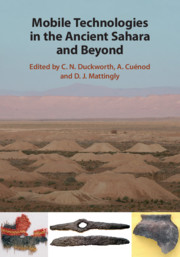Book contents
- Mobile Technologies in the Ancient Sahara and Beyond
- The Trans-Saharan Archaeology Series
- Mobile Technologies in the Ancient Sahara and Beyond
- Copyright page
- Contents
- Figures
- Tables
- Contributors
- Preface
- Part I Introduction
- Part II Technological Mobility and Transfers
- 2 Technological Innovations Transfer through the Hyper-Arid Belt
- 3 The Diffusion of Irrigation Technologies in the Sahara in Antiquity
- 4 Crafts in Roman North Africa
- 5 Movement and Management of Animals in the North and West of Africa from 1000 BC to AD 1000
- 6 The Early History of Weaving in West Africa
- Part III Metallurgy
- Part IV Glass Technology
- Part V Handmade Pottery
- Part VI Conclusion
- Index
- References
6 - The Early History of Weaving in West Africa
A Review of the Evidence
from Part II - Technological Mobility and Transfers
Published online by Cambridge University Press: 18 September 2020
- Mobile Technologies in the Ancient Sahara and Beyond
- The Trans-Saharan Archaeology Series
- Mobile Technologies in the Ancient Sahara and Beyond
- Copyright page
- Contents
- Figures
- Tables
- Contributors
- Preface
- Part I Introduction
- Part II Technological Mobility and Transfers
- 2 Technological Innovations Transfer through the Hyper-Arid Belt
- 3 The Diffusion of Irrigation Technologies in the Sahara in Antiquity
- 4 Crafts in Roman North Africa
- 5 Movement and Management of Animals in the North and West of Africa from 1000 BC to AD 1000
- 6 The Early History of Weaving in West Africa
- Part III Metallurgy
- Part IV Glass Technology
- Part V Handmade Pottery
- Part VI Conclusion
- Index
- References
Summary
In this chapter the early history of weaving in West Africa is discussed in the light of archaeological evidence. The oldest preserved textiles in West Africa were discovered at Kissi in Burkina Faso and dated to the early first millennium AD. They add to the small corpus of first millennium AD textile finds and push back in time the evidence for the demand and use of cloth in sub-Saharan Africa. However, it is unclear whether these earliest textile finds mark the beginning of a weaving tradition south of the Sahara. Rather, archaeological and historical evidence seem to indicate that local woven textile production began relatively late in West Africa, towards the end of the first millennium AD, possibly accelerated by long-distance connections with the north or north-east and the spread of Islam.
- Type
- Chapter
- Information
- Mobile Technologies in the Ancient Sahara and Beyond , pp. 183 - 208Publisher: Cambridge University PressPrint publication year: 2020
References
- 5
- Cited by

